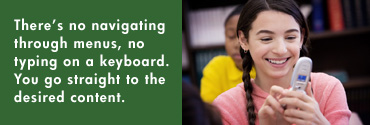
By Anne Stuart, Nov. 2005
Sure, it's possible to use your mobile phone to access
Web information on the go, but who wants to type a URL
on a cell phone keyboard or wade through menu pages to
find the content they want?
Researchers at HP Labs in Bristol, England, want to make
retrieving information as easy as snapping photos or speed
dialing your friends. The idea is to offer content related
to your immediate environment, whether you’re browsing
in your favorite store, taking a self-guided tour of a
historic site, or standing before a poster advertising
a concert you’d like to attend.
To make that possible, they've equipped camera phones
with barcode-reading technology to provide one-click access
to information and services on the move. So far, they've run trials of the technology with the BBC and the British newspaper The Times, among others. (Since this article was first published the team won a prestigious TV award for the BBC project.)
The project grew out of an earlier HP Labs experiment
called Cooltown, in which researchers developed systems
that let users of wireless handheld devices – such
as HP iPAQs – quickly obtain Web content relevant
to their current locations.
“More recently, it became clear that camera phones
were also capable of reading bar codes,” Kindberg
says. And, because such phones are quickly becoming ubiquitous,
they make more sense for ubiquitous computing – that
is, computing wherever you happen to be.
In fact, cell phone-based computing already has caught
on in Japan, where bar-coded messages have popped up in
magazine and newspaper ads, and outdoor posters. According
to one survey, bar-code readers are the third-most requested
feature among Japanese cell-phone customers, trailing only
high-resolution cameras and music capability in popularity.
HP’s Bristol team developed software that, with
Gavitec AG’s image-processing technology as a key
component, lets camera phones read codes and retrieve content.
They have also developed software for content providers
to create and manage bar codes. (Software is currently
only available in the European Union.)
From the user's’ point of view, the technology couldn’t
be easier. When users point the camera phone at a visual
symbol – that is, the bar code – the software
immediately shows it has recognized the code with pop-up
text describing what the code links to. If the user activates
the code, the software either fetches content from the
Web or it sends a text (SMS) message to request the content.
The technology thus takes full advantage of the existing
Mobile Commerce infrastructure.
“There’s no navigating through menus, no typing
on a keyboard,” Kindberg says. “You go straight
to the desired content.”
Providing that kind of fast, easy, direct access is the
technology’s greatest strength.
“You can get the content while you’re still
in the situation,” Kindberg says. For instance, while
reading your morning newspaper on public transport or at
the breakfast table, you could instantly obtain more details
about a particular ad or story by using your phone to scan
an embedded bar code. There's no need to wait until you
get to work or even access your home PC.
Meanwhile, content providers can strategically place bar
codes offering the right people targeted, timely information. “One
of the key benefits is capturing people’s immediate
impulses," Kindberg notes.
The technology also lets businesses offer customized,
location-specific content. For instance, a record company
might print and distribute thousands of posters advertising
a popular band’s new CD.
Each individual poster could contain a unique bar code
with a link to unique content – a poster at a particular
bus stop might link to a message indicating that if you’re
interested in buying that album right now, it’s available
at Ralph’s Records just around the corner.
In one high-profile trial of the technology, researchers
worked with the BBC to augment ‘Coast,’ a TV
series exploring the coastlines of England, Scotland, Wales
and Northern Ireland. Producers mapped out a dozen self-guided
seaside walks in locations featured in the series. At about
100 points on those routes, camera-phone users could download
BBC content explaining the significance of their current
locations and directing them to the next tour stop.
In another trial, The Times, a national British newspaper,
gave away an HP desktop computer in a contest that players
needed to collect three virtual tokens printed in the paper
in late August 2005. Contestants could enter either by
manually keying in their token numbers or by simply scanning
the tokens’ bar codes with their cell phones – the
latter, of course, being the less laborious process.
Bristol-based record company Hope Recordings tested the
technology by putting bar codes on a new two-CD retrospective,
7 Year Itch, allowing fans to access video clips of musicians.
The Watershed, a digital arts center in Bristol, used it
to promote an animated film festival.
Researchers who observed and interviewed trial users say
they found that code reading lowers the barriers to user
engagement compared to conventional phone service access
methods. The BBC ‘Coast’ trial, in particular,
further showed that well-placed codes lead to situations
in which the close relationship between the content and
the physical situation felt special to the users.
In the not-too-distant future, researchers believe people
will use the technology to download music and video samples,
order event tickets, play games, summon taxicabs, get instant
in-store discounts and lots more.
That's not to say that researchers don't have challenges
ahead. For one thing, “you can’t just put bar
codes anywhere you like,” Kindberg notes. Health
and safety regulations sometimes require posting the bar
codes higher than some people can easily see or reach with
their phones; preservation laws often prohibit the posting
of any signs on historic buildings and other landmarks
likely to be included on self-guided tours.
In addition, limitations on camera-phone optics outside
Japan mean that bar codes must be printed in a large format
that some companies will find tough to incorporate into
graphic designs. (Japanese camera phones have a macro capability,
so codes are much smaller, and therefore easier to blend
into artwork.) Also, camera phones won’t read the
bar codes if they’re held too far away or at the
wrong angle. Finally, the technology currently only works
on a few high-end Nokia and Siemens phones.
But Kindberg predicts that the phones will quickly become
more sophisticated, more forgiving and more widely available
as early as sometime in 2006.
Meanwhile, the technology continues to develop: “We
envision it as being extensible the same way the Web is
extensible,” he says. In other words, there’s
no telling what that cell phone of yours might be able
to do next.
Anne Stuart is a Boston-based freelance journalist who has written
about business, technology, and the Internet for more than a
decade.
|

